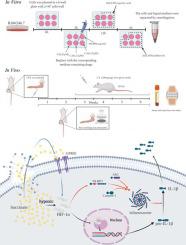International Immunopharmacology ( IF 4.8 ) Pub Date : 2020-05-12 , DOI: 10.1016/j.intimp.2020.106570 Panwang Liu 1 , Jie Wang 1 , Wen Wen 1 , Ting Pan 1 , Huan Chen 1 , Ying Fu 1 , Fushun Wang 2 , Jason H Huang 3 , Shijun Xu 1

|
Cinnamaldehyde (CA) is an essential component of cinnamon (Cinnamomum cassia Presland), which is often used as a flavoring condiment in beverages, pastries, perfumes, etc. Cinnamon is also used as herbal medicine in China and Southeast Asia to treat rheumatoid arthritis. However, the molecular mechanism is unclear. In this study, we aim to investigate its anti-inflammatory effects against Rheumatoid arthritis (RA) using activated macrophages (Raw246.7) in vitro and adjuvant arthritis rats (AA) in vivo. The results demonstrated that CA significantly reduced synovial inflammation in AA rats, possibly due to suppression of the expressions of pro-inflammatory cytokines, especially the IL-1β. Further investigation found that CA also suppressed the activity of HIF-1α by inhibiting the accumulation of succinate in cytoplasm. As we know, the reduction of HIF-1α nucleation slows down IL-1β production, because HIF-1α activates the expression of NLRP3, which is involved in the assembly of inflammasome and processing of IL-1β. In addition, CA also inhibited the expression of the succinate receptor GPR91, which in turn inhibited the activation of HIF-1α. In conclusions, our results suggested that CA might be a potential therapeutic compound to relieve rheumatoid arthritis progress by suppressing IL-1β through modulating succinate/HIF-1α axis and inhibition of NLRP3.











































 京公网安备 11010802027423号
京公网安备 11010802027423号